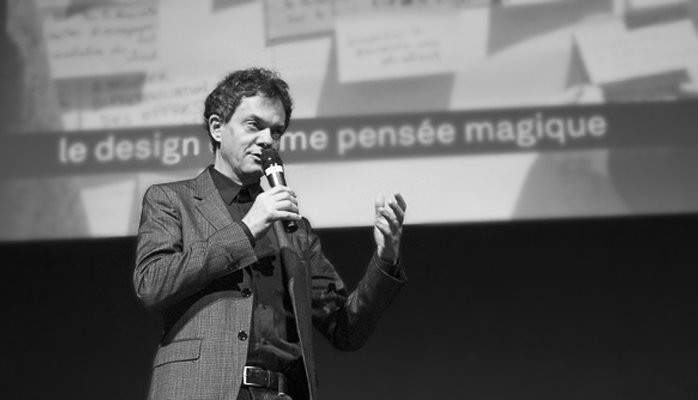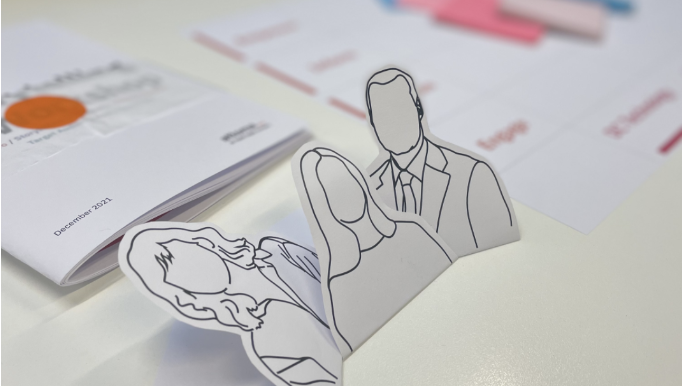What’s really going on when we think we’re doing “design”? A question that is particularly relevant in today’s context. At a time when the urgent need for social and industrial transformations requires new ways of thinking and approaches, I believe we must also question the meaning behind our practices as designers. What is really going on underneath the all-powerful design narratives we graciously adhere to? How sincere and effective are the rhetoric and practices that govern the daily operations of a design agency, and are they suited to deal with the critical challenges we face?
Here I take up the thread of a reflection that originated some ten years ago, when at the invitation of Marina Wainer I had the opportunity to propose a first bit of questioning on the occasion of an evening in the *dizain* series, an initiative organized at the time by the association Designers Interactifs, in October 2015 at the Grand Palais. The video of this short speech can be viewed here
I was frankly surprised by the favorable response to this presentation, which was born of a rather intimate spirit. In the meetings that followed, I had a fascinating discussion with Milan Guenther, who suggested that I explore and develop these intuitions in a longer, more participatory format.
This eventually became a Master Class project within the framework of one of the editions of the Intersection Conference,, namely the 2016 edition in Copenhagen.
Entitled Sense of doubt: What we actually do when we think we’re doing “design” and conceived with Ilaria Monteverdi, this master class took an anthropological approach to deciphering the narratives and beliefs surrounding the notion of “design”, as used in common formulations – UX Design, Design Thinking, Service Design… The aim was to engage participants in questioning the implicit meanings that this catch-all jargon conveys, and to observe, in an experimental way, what biases this can produce in thinking about a concrete business case. The idea was – and still is – the following: the whole set of rituals and processes that make up design seems to have now become an implicit and incontestable belief – while we systematically experience a crowd of screaming misunderstandings about its deep meaning. We are immersed in the images projected by a kaleidoscope of different visions, polished by a jargony varnish that gives us the illusion of evolving in a coherent and shared system of universal practices. Lors de la master class, qui avait été pensée sous la forme d’un atelier collaboratif ouvert à une trentaine de participants, provenant de parcours variés, nous avions eu l’occasion d’initier un questionnement autour de la nature du « dieu design » et de ses pratiques connexes. This was the beginning of a reflection that I have since sought to develop through the opportunities offered by professional practice with my team at Attoma (now Assist Digital France). To effectively meet the needs of businesses and organizations, it is no longer enough to simply roll out self-referential methodological mechanics. We need to step back and confront operational practices with beliefs, analyze the biases and conditioning that structure the narrative of what we think we are doing, in light of what is actually produced and its real impact. Among the key questions:
- What tautologies are used to construct and reinforce the grand narrative of “design”, which some like to imagine as a sacred path capable of solving all sorts of human, social, environmental and industrial problems?
- Why has there been a shift towards a vocabulary and rhetoric that seems to come straight out of a revealed neo-religion?
- To what extent does the ideological and methodological doxa, by a self-predictive mechanism, create the conditions for reinforcing the status quo that we would like to change, paradoxically playing a role in hindering innovation?
When I have the opportunity to deliver this speech, as I did recently in Brussels at the PechaKucha Night Vol. 66, organized in May 2023 by my dear friend Alok Nandi, it’s as if the audience is witnessing the live tearing of the veil of Maya. It is both exhilarating and frustrating: it all seems obvious, and yet, landing this reflection on the ground of projects seems like an unattainable goal. My intuition is that we have reached the end of the “thinking about design” that we have been deploying, without any significant evolution, for more than two decades. Yet, the world is no longer the same, and we are prisoners of a straitjacket that is increasingly obsolete. This is already a statement. Thinking about what will come next, on the other hand, is another topic.


